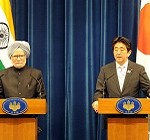During Prime Minister Manmohan Singh’s recent visit to Japan, significant steps were taken on strategically important areas of collaboration such as energy, infrastructure and defence. Both sides agreed to move forward with the civil nuclear collaboration; Japan’s quake-resistant technology and training are part of this proposed deal. The agreement on collaboration on high-speed railways will draw on decade-old Japanese expertise. The agreement on amphibian planes is an unprecedented move in terms of defence-related exports from Japan, which became possible only after a recent change in Japanese laws.
The India-Japan partnership has to be viewed in a larger Asian context. India has played a central role in the history of Asia. For example, the exchange of scholars between India and various Asian countries flourished for centuries. By contrast, Japan remained a closed island country until recent times, but rapidly grew as the first modern developed country in Asia, contributing technology and capital across the region.
A strong connection throughout Asia is Buddhism, which originated in India and spread across the region, including Japan. The common ground of Buddhism is one reason why Indians trust and respect Japan. The Japanese in turn deeply respect Mahatma Gandhi for his principles of non-violence and Rabindranath Tagore, who visited Japan.
Over the decades, India and Japan have collaborated in other fields as well. The collaboration between the founder of the Tata Group in India, Jamsetji Tata, and the “father of Japanese capitalism,” Eichi Shibisawa, was remarkable. Japan’s victory over Russia in the Russian-Japanese War (1904-1905) inspired India, and the nationalist leader Subhas Chandra Bose worked closely with Japan. The remarks of Indian justice Rabhadinod Pal, the sole dissenting judge at the International Military Tribunal in Tokyo following World War II, are still appreciated in Japan, which has built a monument in his honour at the Yasukuni Shrine.
The supply of natural resources and the early establishment of an Indian diplomatic mission in Japan during the critical time of Japan’s efforts to re-establish itself after the war furthered the warmth between the two nations. As Japan regained its financial and industrial strength, India was the first, and continues to be the largest, recipient of official Japanese development assistance, which has helped India in education, healthcare, water supply, power and transport.
In the broader Asian context, Japan is the largest financier of the Asian Development Bank (ADB), while India is the largest recipient of loans from the ADB. Multilateral defence exercises across the region have closely involved both India and Japan, which is a sign of trust.
As the first developed country in Asia, Japan has strong footprints across the region in terms of technology and capital. Japan holds more patents than all of Asia combined, and not only for domestic development. It has taken technology to various countries across Asia, as well as made major contributions in developing infrastructure such as railways, roads, ports, airports, and the water and energy sectors. Japan has also contributed greatly to agriculture, education, healthcare and other areas of social development.
Japanese companies have made significant investments in the private sector and own stakes in high-technology manufacturing across Asia. The Tokyo Stock Exchange is the largest in Asia. Japanese capital, both financial and intellectual, will inevitably have a role to play if, for example, a Thailand-based manufacturing company seeks a technology or business alliance with an Indonesian one.
Its strong presence in the business sector across Asia should help Japan play a central role in the Asian economy. But a lack of international human resources has hindered Japan. In contrast, the Indian community has a strong human network across Asia and Indian companies are well-suited to working in multicultural environments.
The advances in communications technology and the ease of travel will increase multilateral collaboration which uses such complementarities. The Mekong-India Industrial Corridor project is one such example, where Japanese government and industry are pursuing connectivity across the region. This involves the construction of new ports in Myanmar and a major highway project connecting Thailand to India via Myanmar. Major oil and gas companies from Japan, India and Australia are also collaborating on an oil exploration project in East Timor.
The approximately 100,000 people of Indian origin in both Thailand and Indonesia could be a people-to-people bridge in alliances involving Japanese technology and capital.
Many parts of Asia lack adequate infrastructure and skilled human resources, but have large populations and the potential for rapid growth. A comprehensive regional approach will work best to meet the growing demands of infrastructure, manufacturing, services and human resources. Using modern management capabilities, a model for collaboration between Japan and India can be developed for Asia, in which Japan can lead in terms of technology and capital, and India can lead from the global human resources end. This could be a winning recipe for growth in Asia. This indeed was an underlying theme in the recent bilateral discussions between the two prime ministers.
Sanjeev Sinha is President, Sun and Sands Group and Sun and Sands Advisors . He is the Country Representative in Japan for Tata Asset Management and Tata Realty and Infrastructure; Advisor, Indian Scientists Association in Japan; President, Japan India Auto Components Association; Japan Director, Global Association for Risk Professionals. Sinha was formerly with UBS, Mizuho Securities, Goldman Sachs, Gentech Corp and Godrej.
This blog was exclusively written for Gateway House: Indian Council on Global Relations. You can read more exclusive content here.
For interview requests with the author, or for permission to republish, please contact outreach@gatewayhouse.
© Copyright 2013 Gateway House: Indian Council on Global Relations. All rights reserved. Any unauthorized copying or reproduction is strictly prohibited


